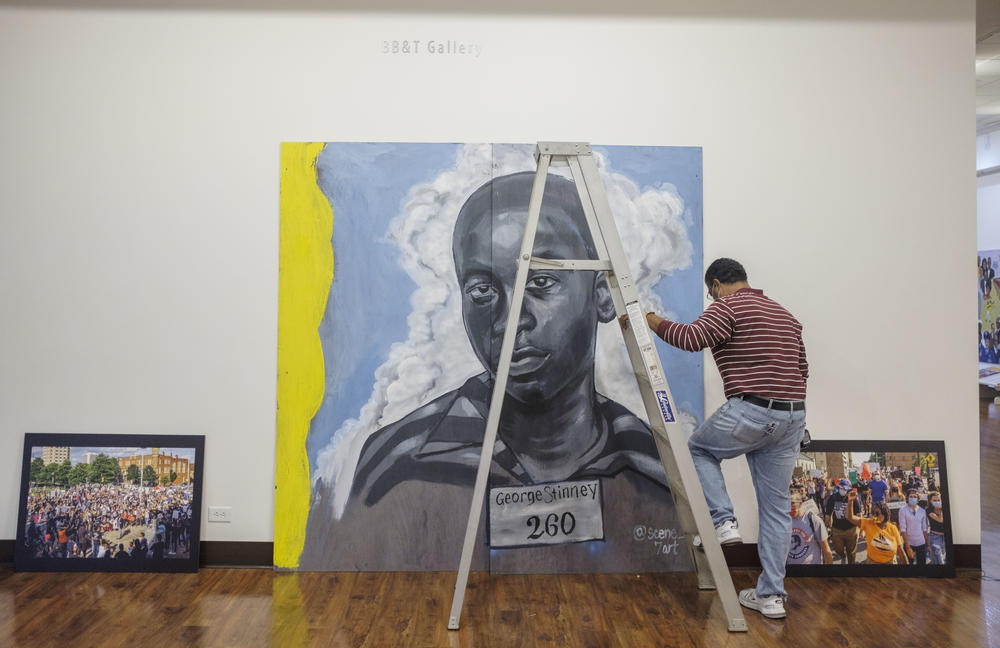
Section Branding
Header Content
Macon museum's 'Block the Hate' exhibit is aimed at taking you back to the summer of 2020
Primary Content
The flare of activism around the movement for Black lives in Macon in 2020 was intense, brief and, thankfully, well documented.
Now the Block the Hate exhibit at the Tubman African American Museum will create a space for work documenting the summer of one and a half years ago in Macon while also providing a space for confronting the city’s past.
The core of the exhibit is the set of plywood walls that made up the box that temporarily encased the dais of the Confederate statue at the bottom of Cotton Avenue.
“I mean, these are going to be thrown away, basically,” Tubman curator Jeff Bruce said.
Today the plywood panels are warped and bowed, a challenge to secure to a gallery wall, Bruce said. Even that won’t let the messages of Black empowerment last forever. But Bruce said they still have a job they can do.
“When George Floyd was killed, to about the end of July, here in Macon, there was a lot of activity,” Bruce said. "There was a lot of stuff going on. A lot of people doing things — positive things, negative things. There was a lot of social interaction, social momentum for change.”
That momentum led to a march for social justice that drew hundreds.
But after those two big events — the march and the boxing of the statue — Bruce said, from his point of view, the energy around racial equity in the city largely subsided.
“I wanted to talk about that period of activity,” Bruce said. “And have people kind of go back to that time and go back to that place a little bit. And hopefully recapture some of that energy and recapture some of that desire to make some kind of positive change.”
Kevin Lewis’ portrait of George Stinney is one of the pieces of art Bruce has now curated.
“It was just kind of really temporary,” Lewis said of the piece. "It's really raw. It wasn't planned out. I'm really just, like, honored and humbled. I'm glad that they kept it.”

Stinney was the young Black teenager who was executed by the state of South Carolina in 1944 at the age of 14, making him still the youngest American to have been executed. Lewis said Stinney was on his mind in 2020 in part because of the conversations he’d been having with his then-15-year-old son.
“He was born in Germany," Lewis said. "He spent all of his life being a military brat and was able to bounce around different countries and have this great luxury.”
Then, the family came back stateside and Lewis found himself forced to tell his son what it meant to be Black in America.
“It was just more of a kind of give him education on, ‘Hey man, you know, America is great, but we still have some serious pitfalls here, and I need you to be aware,’” Lewis said.
Bruce said Lewis’ painting and the rest of the art documenting the summer of 2020 in Macon will hopefully lead to a more permanent public monument to Macon’s past.
For years, there has been some talk that Macon should acquire the copy of the memorial marker for seven lynching victims in the city on display at the National Lynching Memorial in Montgomery, Ala.
That memorial is curated by the Equal Justice Initiative. Bringing the marker to Macon would first require a formalized process of truth and reconciliation undertaken with the EJI, called the Community Remembrance Project.
Jeff Bruce said his aim, as well as the aim of collaborators at Wesleyan College and the group Building Democratic Futures, is for the Block the Hate exhibit to kindle conversations to begin the Community Remembrance Project and eventually bring the Macon lynching memorial to the city.
The Block the Hate exhibit will be on display at the Tubman African American Museum in Macon at least through February.


